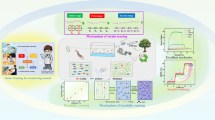Abstract
The electro-spinning of silk has attracted the attention of researchers in biomedical fields because of 1) the unique properties of silk, including its biocompatibility, and 2) the simplicity of electro-spinning for nanoweb fabrication. Although there are hundreds of varieties of Bombyx mori, the effect of silkworm variety has not been investigated in the study of silk electro-spinning. As an effort to develop electro-spun silk with diverse performances, the effect of Korean silkworm variety on the electro-spinning of silk fibroin (SF) was examined in this study. The regenerated SF solutions showed different viscosities depending on the silkworm variety, which resulted in differences in the maximum electro-spinning rates and diameters of electro-spun SF fibers. However, the crystallization of SF during electro-spinning and the water content of the electro-spun SF webs remained the same between different silkworm varieties.
Similar content being viewed by others
References
B. M. Min, G. Lee, S. H. Kim, Y. S. Nam, T. S. Lee, and W. H. Park, Biomaterials, 25, 1289 (2004).
C. S. Ki, S. Y. Park, H. J. Kim, H. M. Jung, K. M. Woo, J. W. Lee, and Y. H. Park, Biotechnol. Lett., 30, 405 (2008).
H. J. Jin, J. Chen, V. Karageorgiou, G. H. Altman, and D. L. Kaplan, Biomaterials, 25, 1039 (2004).
W. Y. Lee, I. C. Um, M. K. Kim, K. J. Kweon, S. G. Kim, and Y. W. Park, Maxillofac. Plast. Reconstr. Surg., 36, 280 (2014).
A. Schneider, X. Y. Wang, D. L. Kaplan, J. A. Garlick, and C. Egles, Acta Biomater., 5, 2570 (2009).
J. Kim, C. H. Kim, C. H. Park, J. N. Seo, H. Y. Kweon, S. W. Kang, and K. G. Lee, Wound Repair Regen., 18, 132 (2010).
J. Y. Song, S. G. Kim, J. W. Lee, W. S. Chae, H. Kweon, Y. Y. Jo, K. G. Lee, Y. C. Lee, J. Y. Choi, and J. Y. Kim, Oral Surg. Oral Med. Oral Pathol. Oral Radiol., 112, e26 (2011).
S. Y. Park, C. S. Ki, Y. H. Park, K. G. Lee, S. W. Kang, H. Y. Kweon, and H. J. Kim, J. Tissue Eng. Regen. Med., 9, 66 (2015).
H. Kweon, K. G. Lee, C. H. Chae, C. Balazsi, S. K. Min, J. Y. Kim, J. Y. Choi, and S. G. Kim, J. Oral Maxillofac. Surg., 69, 1578 (2011).
H. Sakabe, H. Ito, T. Miyamoto, Y. Noishiki, and W. S. Ha, Sen-I Gakkaishi, 45, 487 (1989).
I. C. Um, H. Y. Kweon, C. M. Hwang, B. G. Min, and Y. H. Park, Int. J. Ind. Entomol., 5, 165 (2002).
J. W. Kim, C. S. Ki, Y. H. Park, H. J. Kim, and I. C. Um, Macromol. Res., 18, 442 (2010).
M. Santin, A. Motta, G. Freddi, and M. Cannas, J. Biomed. Mater. Res., 46, 382 (1999).
T. Arai, G. Freddi, R. Innocenti, and M. Tsukada, J. Appl. Polym. Sci., 91, 2383 (2004).
D. E. Chung, H. H. Kim, M. K. Kim, K. H. Lee, Y. H. Park, and I. C. Um, Int. J. Biol. Macromol., 79, 943 (2015).
J. S. Ko, K. Yoon, C. S. Ki, H. J. Kim, D. G. Bae, K. H. Lee, Y. H. Park, and I. C. Um, Int. J. Biol. Macromol., 55, 161 (2013).
K. Yoon, H. N. Lee, C. S. Ki, D. Fang, B. S. Hsiao, B. Chu, and I. C. Um, Int. J. Biol. Macromol., 61, 50 (2013).
H. J. Kim and I. C. Um, Korea-Australia Rheol. J., 26, 119 (2014).
H. J. Cho, Y. J. Yoo, J. W. Kim, Y. H. Park, D. G. Bae, and I. C. Um, Polym. Degrad. Stabil., 97, 1060 (2012).
H. J. Cho, C. S. Ki, H. Oh, K. H. Lee, and I. C. Um, Int. J. Biol. Macromol., 51, 336 (2012).
D. E. Chung and I. C. Um, Fiber. Polym., 15, 153 (2014).
H. J. Kim and I. C. Um, Int. J. Biol. Macromol., 67, 387 (2014).
T. Hodgkingson, Y. Chen, A. Bayat, and X. F. Yuan, Biomacromolecules, 15, 1288 (2014).
P. Gupta, C. Elkins, T. E. Long, and G. L. Wilkes, Polymer, 46, 4799 (2005).
C. Mit-uppatham, M. Nithitanakul, and P. Supaphol, Macromol. Chem. Phys., 205, 2327 (2004).
I. C. Um, H. Kweon, Y. H. Park, and S. Hudson, Int. J. Biol. Macromol., 29, 91 (2001).
Y. N. Jo and I. C. Um, Int. J. Biol. Macromol., 78, 287 (2015).
I. C. Um, H. Y. Kweon, K. G. Lee, and Y. H. Park, Int. J. Biol. Macromol., 33, 203 (2003).
Author information
Authors and Affiliations
Corresponding author
Rights and permissions
About this article
Cite this article
Park, B.K., Um, I.C. Effect of Korean Bombyx mori variety on electro-spinning performance of regenerated silk fibroin. Fibers Polym 16, 1935–1940 (2015). https://doi.org/10.1007/s12221-015-5472-x
Received:
Revised:
Accepted:
Published:
Issue Date:
DOI: https://doi.org/10.1007/s12221-015-5472-x




